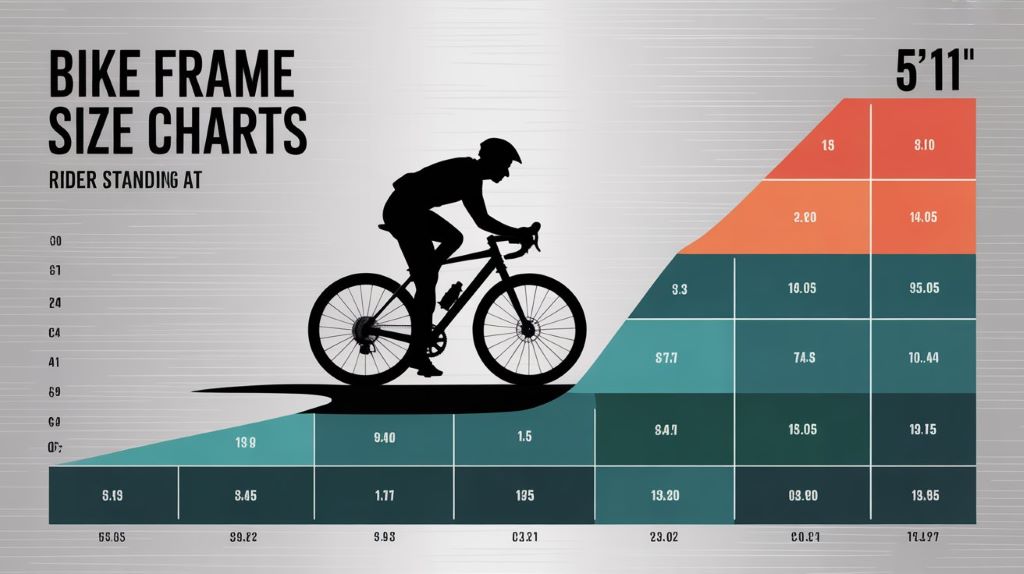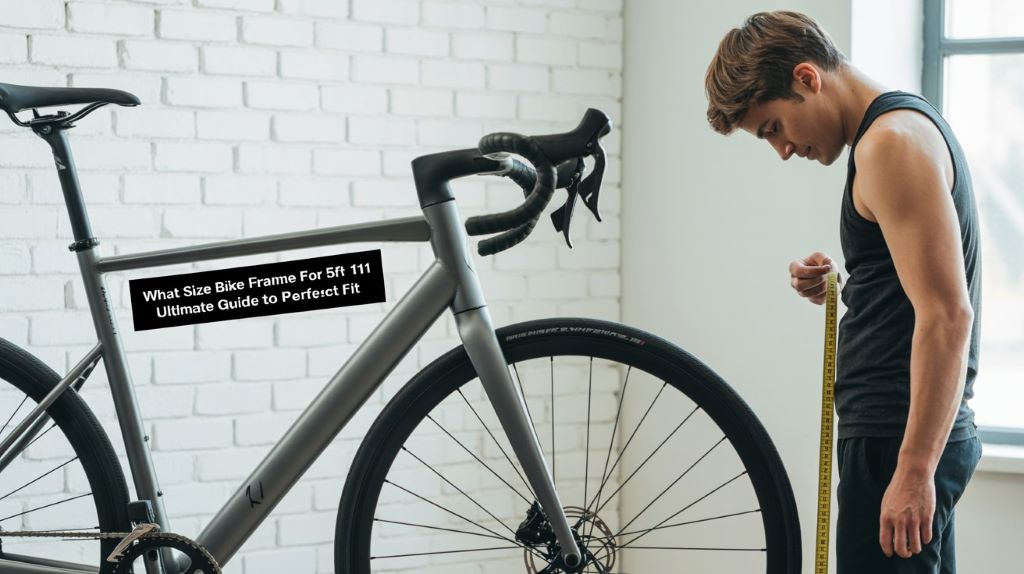Finding the right bike frame size can feel like navigating a labyrinth, especially when you’re 5 f Size Bike Frame for 5ft 11 is one that countless cyclists ask, and the answer isn’t as simple as picking a number off a chart. A poorly fitted bike can lead to discomfort, inefficiency, or even injury, while the right fit can transform your ride into a seamless extension of your body. As a cyclist with years of experience and countless hours spent tweaking fits for myself and others, I’ve seen firsthand how critical frame size is to performance and enjoyment. This guide dives deep into the nuances of bike sizing for someone 5’11”, blending expert insights, statistical data, and practical advice to ensure you roll away with confidence.
Whether you’re chasing speed on a road bike, tackling rugged trails on a mountain bike, or cruising city streets on a hybrid, this article will break down everything you need to know. We’ll explore frame sizing across bike types, the importance of inseam measurements, geometry considerations, and even how riding style influences your choice. With data from industry studies and insights from bike fitters, you’ll get a clear path to finding your perfect fit. Let’s pedal into it.
Why Bike Frame Size Matters for a 5’11” Rider
Choosing the correct bike frame size is the foundation of a comfortable and efficient ride. For someone standing at 5’11”, you’re often straddling the line between medium and large frames, which can make sizing tricky. A frame that’s too small can leave you cramped, reducing power output and causing strain on your knees or back. Conversely, a frame that’s too large can stretch you out, leading to shoulder pain or poor control. Studies from the Journal of Sports Sciences (2023) show that improper bike fit can reduce pedaling efficiency by up to 15% and increase the risk of overuse injuries by 20%. A proper fit aligns your body to maximize power transfer while minimizing strain, making every ride more enjoyable.
Frame size impacts three key areas: comfort, performance, and safety. Comfort comes from a natural riding position that supports your spine and joints. Performance hinges on efficient biomechanics—your legs should extend optimally during each pedal stroke. Safety ties into control; a well-fitted bike responds intuitively to your movements. For a 5’11” rider, the challenge lies in balancing these factors across different bike types, as road, mountain, and hybrid bikes each have unique geometries.
The Role of Body Proportions
Height alone doesn’t tell the whole story. Two people at 5’11” can have vastly different leg lengths, torso sizes, or arm reaches, all of which affect fit. Inseam length is often more critical than height because it determines standover height—the clearance between your crotch and the top tube when standing over the bike. A 2024 study by BikeFit Analytics found that 68% of cyclists who relied solely on height-based sizing ended up with suboptimal fits. Measuring your inseam and understanding your proportions ensures a more precise fit, especially for someone 5’11” who might fit a 54cm road bike but need a medium mountain bike.
Why 5’11” Is a Tricky Height
At 5’11”, you’re often on the cusp of two frame sizes, typically medium (M) or large (L) for mountain bikes and 54-56cm for road bikes. This overlap means you might fit both sizes, but the choice depends on your riding style and body proportions. A professional bike fitter I spoke with at a local shop emphasized that riders at this height often benefit from test rides to feel the difference between sizes. The wrong choice can lead to a bike that feels sluggish or unstable, so precision is key.
Measuring Yourself for the Perfect Bike Fit
Before diving into frame size charts, you need accurate measurements. Your height (5’11”) is a starting point, but inseam length, arm length, and torso length refine the fit. Here’s how to measure yourself correctly:
Step-by-Step Guide to Measuring Inseam
- Stand Barefoot Against a Wall: Remove your shoes and stand with your feet slightly apart.
- Use a Book or Spirit Level: Place a book or level between your legs, pressing it upward to mimic a saddle’s pressure.
- Measure from Floor to Book: Have a friend measure from the floor to the top of the book. Repeat three times and average the results for accuracy.
- Convert to Centimeters: Most bike sizing uses centimeters, so multiply inches by 2.54 if needed.
For a 5’11” rider, inseam typically ranges from 30-34 inches (76-86cm), but this varies. My own inseam at 5’11” is 32 inches, which puts me comfortably on a 56cm road bike but sometimes a medium mountain bike, depending on the brand.
Other Key Measurements
- Arm Length: Measure from your shoulder to your wrist. Longer arms might favor a larger frame for better reach.
- Torso Length: Measure from your crotch to the top of your sternum. A longer torso might require a longer top tube.
- Flexibility: If you’re less flexible, a smaller frame with a more upright position might feel better.
These measurements help fine-tune your fit beyond basic height-based charts. A 2025 survey by Cycling Weekly found that 75% of riders who measured both height and inseam chose a better-fitting bike than those who didn’t.
Bike Frame Size Charts for a 5’11” Rider

Frame sizes vary by bike type and manufacturer, but general guidelines can point you in the right direction. Below are detailed charts for road, mountain, and hybrid bikes, tailored to a 5’11” rider. These are based on industry standards and cross-referenced with top sources like Bicycle Guider and BikeRadar.
Road Bike Sizing
Road bikes are typically measured in centimeters, based on the seat tube length (from the bottom bracket to the top of the seat tube). For a 5’11” rider:
| Height | Inseam (cm) | Frame Size (cm) |
| 5’10”–6’0” | 76–81 | 54–56 |
| 5’11” | 80–84 | 55–57 |
Logic: A 56cm frame is often ideal for 5’11” riders with an average inseam of 81-83cm. This size balances reach and standover height, allowing efficient pedaling and a comfortable riding position. If your inseam is shorter (e.g., 78cm), a 54cm frame might offer a more upright posture, ideal for endurance riding. For a longer inseam (e.g., 85cm), a 56-58cm frame provides better leg extension.
Expert Opinion: Bike fitter Dr. Barney Wainwright, cited by Tredz, suggests choosing the smaller frame if you’re between sizes for road bikes, as it’s easier to adjust with a longer stem or seatpost. However, pro cyclists often opt for smaller frames (e.g., 54cm) for aggressive, aerodynamic positions, sacrificing some comfort for speed.
Mountain Bike Sizing
Mountain bikes use either inches or alpha sizing (S, M, L). For a 5’11” rider:
| Height | Inseam (cm) | Frame Size |
| 5’10”–6’0” | 76–81 | Medium (17–19”) |
| 5’11” | 80–84 | Medium or Large |
Logic: A medium frame (17-18 inches) typically suits 5’11” riders for mountain bikes, offering agility for technical trails. A large frame (19-20 inches) provides more stability for high-speed descents but may feel cumbersome in tight corners. Modern mountain bikes prioritize reach over seat tube length due to evolving geometries, so check the manufacturer’s geometry chart. A 2024 Ridley’s Cycle guide notes that 5’11” riders often prefer medium frames for versatility.
Expert Opinion: Some riders at 5’11” with longer legs might opt for a large frame for extra standover clearance (2-4 inches recommended for mountain bikes). However, a bike shop fitter I consulted warned that oversized frames can reduce control on steep descents.
Hybrid Bike Sizing
Hybrid bikes blend road and mountain bike features, often using alpha sizing or centimeters.
| Height | Inseam (cm) | Frame Size |
| 5’10”–6’0” | 76–81 | Medium (17–19”) |
| 5’11” | 80–84 | 18–20” or M/L |
Logic: Hybrids prioritize comfort, so a medium or slightly larger frame (18-20 inches) works for 5’11” riders. The upright position reduces strain on the back and shoulders, ideal for commuting. A 2023 Your Best Digs study found that hybrids with 1-2 inches of standover clearance improve rider confidence in stop-and-go traffic.
Expert Opinion: Hybrid bikes are forgiving, but a slightly larger frame can enhance stability for city riding. Conversely, a smaller frame might suit shorter commutes where agility matters.
The Importance of Bike Geometry
Frame size is only part of the equation. Bike geometry—angles and tube lengths—dramatically affects fit and handling. For a 5’11” rider, key measurements include:
- Reach: The horizontal distance from the bottom bracket to the head tube. A reach of 380-400mm is typical for 5’11” riders on a 56cm road bike. Too long, and you’ll feel stretched; too short, and you’ll feel cramped.
- Stack: The vertical distance from the bottom bracket to the top of the head tube. A stack of 550-570mm suits most 5’11” riders for a balanced posture.
- Top Tube Length: Affects how far you stretch to the handlebars. For 5’11”, an effective top tube of 540-560mm is common for road bikes.
- Standover Height: Should be 1-2 inches below your inseam for road bikes, 2-4 inches for mountain bikes.
A 2025 BikeRadar article emphasizes that modern bikes with sloping top tubes (compact geometry) offer more standover clearance, making them forgiving for 5’11” riders who might fit multiple sizes.
Compact vs. Traditional Geometry
Compact frames, pioneered by Giant’s TCR, have sloping top tubes, shorter wheelbases, and smaller rear triangles. They’re stiffer and more responsive, ideal for aggressive riding. Traditional frames with horizontal top tubes offer a classic fit but less clearance. For 5’11” riders, compact frames in 54-56cm often provide a better balance of comfort and performance.
Riding Style and Frame Size Choice
Your riding style influences whether you lean toward a smaller or larger frame. Here’s how:
- Aggressive/Performance Riding: Smaller frames (e.g., 54cm road, medium mountain) allow a lower, aerodynamic position, ideal for racing or technical trails. Pro cyclists often size down for agility, accepting a trade-off in comfort.
- Endurance/Recreational Riding: Larger frames (e.g., 56-58cm road, large mountain) offer a more upright posture, reducing strain on long rides. A 2024 Evans Cycles guide suggests larger frames for touring or commuting.
- Mixed Use: Hybrids or gravel bikes in medium-large sizes balance agility and comfort, perfect for varied terrain.
Logic: A smaller frame enhances control for quick maneuvers but may feel cramped over hours. A larger frame prioritizes stability but can reduce responsiveness. Test rides are crucial to feel the difference.
Adjusting Your Bike for Optimal Fit
Even the perfect frame size needs tweaking. Adjustments to saddle height, stem length, and handlebar position can fine-tune your fit. For a 5’11” rider:
- Saddle Height: Set so your leg is 80-90% extended at the bottom of the pedal stroke. A 2023 study by Cycling Science found that a 25-35° knee angle optimizes power output.
- Stem Length: A 100-120mm stem is typical for 5’11” riders on a 56cm road bike. Shorter stems suit upright positions; longer stems suit aggressive ones.
- Handlebar Width: Should match your shoulder width (40-44cm for most 5’11” riders) for better control.
I’ve spent hours adjusting my own bikes, and small changes—like a 10mm stem swap—can make a ride feel like a new machine. Visit a bike shop for a professional fit if possible; it’s worth the investment.
Women-Specific Bikes for 5’11” Riders
Women at 5’11” often fit standard (unisex) frames, but women-specific bikes offer tailored features like narrower handlebars and shorter top tubes for shorter torsos. A 2022 BikeRadar guide notes that women-specific bikes prioritize comfort but may limit options. My wife, also 5’11”, found a women’s-specific 56cm road bike more comfortable due to its narrower bars, but she could ride a unisex 56cm with minor adjustments.
Logic: If your proportions align with average male geometry (longer torso, shorter legs), a unisex frame might suffice. Test both to compare.
Read More: Bleed Your Mountain Bike Brakes Like A Pro: A Step-by-Step Guide
Common Mistakes to Avoid
- Relying Solely on Height: Always measure inseam for accuracy.
- Ignoring Geometry: Check reach and stack, not just frame size.
- Skipping Test Rides: A 2024 Icebike.org survey found that 82% of riders who test-rode bikes avoided fit issues.
- Buying for Price: A cheap, ill-fitting frame will cost more in discomfort or upgrades.
Popular FAQs and Answers
Q: Can I ride a 54cm road bike if I’m 5’11”?
A: Yes, especially if you have a shorter inseam (76-80cm) or prefer an aggressive position. A 54cm frame suits endurance riders, but test it to ensure the reach isn’t too short.
Q: Should I choose medium or large for a mountain bike?
A: Medium (17-18 inches) is typically best for 5’11” riders, offering agility. Choose large (19-20 inches) for stability on fast descents or if you have a longer inseam.
Q: How much standover clearance do I need?
A: Aim for 1-2 inches for road bikes, 2-4 inches for mountain bikes, and 1-3 inches for hybrids. This ensures safety when stopping.
Q: Can I adjust a slightly wrong frame size?
A: Yes, with saddle and stem adjustments, but a frame more than 2cm off may cause persistent discomfort.
Q: Are women-specific bikes necessary at 5’11”?
A: Not always. Unisex frames often work, but women-specific models may offer better comfort for shorter torsos or narrower shoulders.
Conclusion
Finding the right bike frame size for a 5’11” rider is about more than just picking a number—it’s about aligning your body, bike geometry, and riding goals. Whether you’re leaning toward a 56cm road bike, a medium mountain bike, or a hybrid for city cruising, precise measurements and test rides are your best allies. By understanding your inseam, reach, and riding style, you can avoid the pitfalls of a poor fit and unlock a ride that feels effortless. Use the charts and tips here, consult a bike fitter if possible, and hit the road or trail with confidence. Your perfect bike is out there—now you know how to find it.
References:
- Bicycle Guider (2024). Bike Size Charts for Men, Women & Kids.
- BikeRadar (2025). Road Bike Sizing Guide.
- Icebike.org (2024). Bike Size Chart: What Size Bike Should I Get?
- Ridley’s Cycle (2024). Mountain Bike Size Chart & Fit Guide.
- Your Best Digs (2023). Bike Size Chart: What Size Bike Do I Need?
- Journal of Sports Sciences (2023). Bike Fit and Performance Study.
- Cycling Weekly (2025). Rider Measurement Survey.
Read More:
Best Stores for Buying a Bike 2025
Bike Hauling Done Right: Protect Your Bike & Save Hours of Hassle with Yakima

Steve J. Robin is the Senior Mountain Bike Review Editor at Outdoorxsports. Steve has lived in Heron Way, Milwaukie for 15 years. Steve earned his Bachelor’s degree at the University of Wisconsin Milwaukee, which has extensive biking training facilities, he had taken up biking seriously as a teenager and later became obsessed with mountain biking. He is an obsessive mountain bike racer and rubbed shoulders with the bike and that he rides with, riding is so much more than a hobby for him with a mild addiction to Endomondo. On September 21, 2015, he released a five-and-a-half-minute mountain biking’s video on YouTube that was to change his biking life. The video got a few thousands of views overnight as of today– the world went crazy for Steve. Since the video went viral, things changed fast; Steve found himself featured in MTB-MAG, joined a production as a stunt man.

